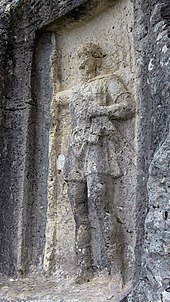Yeniyurt Kalesi
Coordinates: 36 ° 37 ′ 33 ″ N , 34 ° 7 ′ 47 ″ E
Yeniyurt Kalesi (formerly Eski Kale ) is the ruin of a Hellenistic fortress and a settlement in southern Turkey that was inhabited until the early Byzantine period .
location
Yeniyurt Kalesi is located about 1.5 kilometers east of the hamlet of Yeniyurt in the Erdemli district of the Turkish province of Mersin . The fortress lies at the western end of a plateau on a steep rocky ridge, high above the northern bank of the Lamos, today's Limonlu . The distance to the southeastern mouth of the river into the Mediterranean in Limonlu is about 13 kilometers, as is Erdemli, the provincial capital of Mersin , about 50 kilometers away.
description
Hellenistic curtains equipped with three semicircular bastions have been preserved on the northwestern edge of the plateau . Nothing can be seen of the gate construction that Josef Keil and Adolf Wilhelm saw in the late 1920s. In the northeast, part of the walls was renewed in the early Byzantine period, using a Doric triglyph frieze as a spoiler . A Roman burial house with a vaulted chamber was incorporated into the walls as a rectangular bastion.
Up to 50 houses stood on the plateau, which are almost completely destroyed today. Some cubic and bell-shaped cisterns are still there . Keil and Wilhelm were able to observe three church buildings, of which only the foundation walls of a basilica can be seen today. It is 14.05 meters long, of which 5.30 meters is taken by the Naos . The two researchers report a Greek inscription in a tabula ansata on a lintel of the church. It contained an Old Testament prophecy relating to the building of the temple in Jerusalem. The inscription is lost today. Based on the found capitals , the building can be dated to the 6th century. To the north of the castle, on a two-tiered base, stands a temple grave from the Roman imperial era , facing south, on the earlier access route . On the western cliff there are remains of a necropolis from Roman to early Byzantine times with burial houses and chamosoria .
A few meters below the modern road, a rock relief is carved into a niche in the steep north face of the high plateau. It shows about life-size a standing warrior in frontal representation. He has long falling hair and is dressed in a short, belted chiton . The right hand holds a lance, the left a sword.
literature
- Friedrich Hild , Hansgerd Hellenkemper : Kilikien and Isaurien. Tabula Imperii Byzantini Volume 5. Verlag der Österreichischen Akademie der Wissenschaften, Vienna 1990, ISBN 3-7001-1811-2 , p. 320 fig. 462.
- Josef Keil, Adolf Wilhelm: Monuments from the Rough Kilikien. (= Monumenta Asiae minoris antiqua vol. 3). London 1931, p. 98 Inscr. 99-100.


